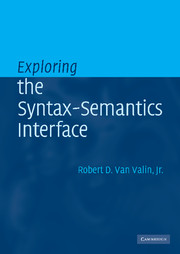Book contents
- Frontmatter
- Contents
- List of figures
- List of tables
- Preface
- List of abbreviations
- Introduction
- 1 Syntactic structure
- 2 Lexical representation and semantic roles
- 3 Information structure
- 4 Syntactic relations and case marking
- 5 Linking syntactic and semantic representations in simple sentences
- 6 The structure of complex sentences
- 7 Linking syntax and semantics in complex sentences
- References
- Languages index
- Subject index
4 - Syntactic relations and case marking
Published online by Cambridge University Press: 18 December 2009
- Frontmatter
- Contents
- List of figures
- List of tables
- Preface
- List of abbreviations
- Introduction
- 1 Syntactic structure
- 2 Lexical representation and semantic roles
- 3 Information structure
- 4 Syntactic relations and case marking
- 5 Linking syntactic and semantic representations in simple sentences
- 6 The structure of complex sentences
- 7 Linking syntax and semantics in complex sentences
- References
- Languages index
- Subject index
Summary
General considerations
An important locus of the interaction of syntax, semantics and pragmatics is grammatical relations. RRG takes a rather different view of grammatical relations from other theories. In the first place, it does not consider them to be basic, nor does it derive them from structural configurations. Second, it recognizes only one syntactic function, not up to three like other theories; there is nothing in RRG corresponding to notions like direct object and indirect object. The syntactic function posited in RRG is not, therefore, part of the same system of oppositions as the traditional notions of grammatical relations (i.e. subject vs direct object vs indirect object), and consequently it is not really comparable to the traditional notion that is its closest analogue, subject. Third, RRG does not assume that grammatical relations are universal, in two senses. On the one hand, it does not claim that all languages must have grammatical relations in addition to semantic roles, which are universal. On the other hand, in those languages in which a non-semantic grammatical relation can be motivated, the syntactic function posited need not have the same properties in every language; that is, the role of this syntactic function in the grammar of language X may be very different from that played by the syntactic function in language Y, and, consequently, the two cannot be considered to be exactly the same. Variation in grammatical relations systems is directly related to differences in the syntax–semantics–pragmatics interface across languages.
- Type
- Chapter
- Information
- Exploring the Syntax-Semantics Interface , pp. 89 - 127Publisher: Cambridge University PressPrint publication year: 2005

